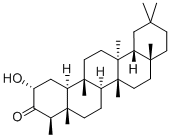4-TERT-PENTYLCYCLOHEXANONE
- CAS NO.:16587-71-6
- Empirical Formula: C11H20O
- Molecular Weight: 168.28
- MDL number: MFCD00013798
- EINECS: 240-642-0
- SAFETY DATA SHEET (SDS)
- Update Date: 2024-12-18 14:08:57

What is 4-TERT-PENTYLCYCLOHEXANONE?
Chemical properties
4-TERT-PENTYLCYCLOHEXANONE is a colorless liquid, d20
4 0.919–0.927, n20
D 1.466–1.471,with a
powerful, orris-type aroma. Hydrogenation of p-tert-amylphenol over palladium
in the presence of borax is described for its synthesis.
It is useful in perfume compositions for, for example, laundry detergents.
Occurrence
Has apparently not been reported to occur in nature.
The Uses of 4-TERT-PENTYLCYCLOHEXANONE
It finds its application as a masking agent and a perfuming agent in cosmetic industry.
Preparation
From 4-tert-amylcyclohexanol by chromic acid oxidation (Arctander, 1969).
Flammability and Explosibility
Non flammable
Trade name
Orivone (IFF)
Safety Profile
Mildly toxic by ingestion. A skinirritant. When heated to decomposition it emits smokeand acrid fumes.
Properties of 4-TERT-PENTYLCYCLOHEXANONE
| Melting point: | 96°C |
| Boiling point: | 124-125°C 16mm |
| Density | 0.92 |
| vapor pressure | 4.2Pa at 24℃ |
| refractive index | 1.4690 |
| Flash point: | 124-125°C/16mm |
| storage temp. | Sealed in dry,Room Temperature |
| solubility | Insoluble in water, soluble in alcohol and perfume materials. |
| form | Solid |
| color | A colourless liquid with a powerful earthy odour |
| Odor | Very powerful, diffusive, woody-camphoraceous odor, slightly earthy. |
| Water Solubility | Soluble in alcohol. Insoluble in water. |
| BRN | 2240475 |
| CAS DataBase Reference | 16587-71-6(CAS DataBase Reference) |
| EPA Substance Registry System | Cyclohexanone, 4-(1,1-dimethylpropyl)- (16587-71-6) |
Safety information for 4-TERT-PENTYLCYCLOHEXANONE
| Signal word | Danger |
| Pictogram(s) |
 Exclamation Mark Irritant GHS07 |
| GHS Hazard Statements |
H315:Skin corrosion/irritation H319:Serious eye damage/eye irritation H335:Specific target organ toxicity, single exposure;Respiratory tract irritation |
| Precautionary Statement Codes |
P261:Avoid breathing dust/fume/gas/mist/vapours/spray. P304+P340:IF INHALED: Remove victim to fresh air and Keep at rest in a position comfortable for breathing. P305+P351+P338:IF IN EYES: Rinse cautiously with water for several minutes. Remove contact lenses, if present and easy to do. Continuerinsing. P405:Store locked up. |
Computed Descriptors for 4-TERT-PENTYLCYCLOHEXANONE
New Products
Tert-butyl bis(2-chloroethyl)carbamate 4-Methylphenylacetic acid N-Boc-D-alaninol N-BOC-D/L-ALANINOL N-octanoyl benzotriazole 3-Morpholino-1-(4-nitrophenyl)-5,6-dihydropyridin- 2(1H)-one Furan-2,5-Dicarboxylic Acid DIETHYL AMINOMALONATE HYDROCHLORIDE 1,1’-CARBONYLDIIMIDAZOLE R-2-BENZYLOXY PROPIONIC ACID 1,1’-CARBONYLDI (1,2-4 TRIAZOLE) N-METHYL INDAZOLE-3-CARBOXYLIC ACID (2-Hydroxyphenyl)acetonitrile 4-Bromopyrazole 5-BROMO-2CYANO PYRIDINE 5,6-Dimethoxyindanone 5-broMo-2-chloro-N-cyclopentylpyriMidin-4-aMine 2-(Cyanocyclohexyl)acetic acid 4-methoxy-3,5-dinitropyridine 1-(4-(aminomethyl)benzyl)urea hydrochloride 2-aminopropyl benzoate hydrochloride diethyl 2-(2-((tertbutoxycarbonyl)amino) ethyl)malonate tert-butyl 4- (ureidomethyl)benzylcarbamate Ethyl-2-chloro((4-methoxyphenyl)hydrazono)acetateRelated products of tetrahydrofuran








You may like
-
 4-(TERT.-PENTYL)-CYCLOHEXANONE CAS 16587-71-6View Details
4-(TERT.-PENTYL)-CYCLOHEXANONE CAS 16587-71-6View Details
16587-71-6 -
 1975-50-4 98%View Details
1975-50-4 98%View Details
1975-50-4 -
 2-HYDROXY BENZYL ALCOHOL 98%View Details
2-HYDROXY BENZYL ALCOHOL 98%View Details
90-01-7 -
 2-Chloro-1,3-Bis(Dimethylamino)Trimethinium Hexafluorophosphate 221615-75-4 98%View Details
2-Chloro-1,3-Bis(Dimethylamino)Trimethinium Hexafluorophosphate 221615-75-4 98%View Details
221615-75-4 -
 61397-56-6 CIS BROMO BENZOATE 98%View Details
61397-56-6 CIS BROMO BENZOATE 98%View Details
61397-56-6 -
 14714-50-2 (2-Hydroxyphenyl)acetonitrile 98+View Details
14714-50-2 (2-Hydroxyphenyl)acetonitrile 98+View Details
14714-50-2 -
 118753-70-1 98+View Details
118753-70-1 98+View Details
118753-70-1 -
 733039-20-8 5-broMo-2-chloro-N-cyclopentylpyriMidin-4-aMine 98+View Details
733039-20-8 5-broMo-2-chloro-N-cyclopentylpyriMidin-4-aMine 98+View Details
733039-20-8
Statement: All products displayed on this website are only used for non medical purposes such as industrial applications or scientific research, and cannot be used for clinical diagnosis or treatment of humans or animals. They are not medicinal or edible.